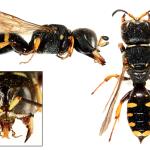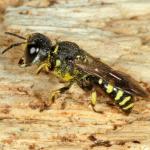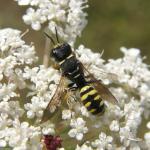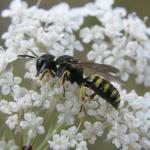Crabro alatulus (DAHLBOM,1838); Crabro auratus (SMITH,1856); Crabro cristatus (PACKARD,1866); Crabro cubiceps (PACKARD,1866); Crabro heraclei (ROHWER,1908); Crabro montanus (CRESSON,1865); Crabro montivagans (STRAND,1916); Solenius octavonotatus (LEPELETIER & BRULLÉ,1835); Solenius octonotatus (LEPELETIER & BRULLÉ,1835); Crabro pictipes (HERRICH-SCHÄFFER,1841)
The more frequent of the two Ectemnius species with short mesonotal pubescence and a pronotum with spines (subgenus Ectemnius). It has been suggested that E. dives is a relatively recent colonist possibly introduced with timber, as the first British record was in 1926 (Nixon, 1935).
Records are concentrated in south-east England and Yorkshire, and are notably sparse in the Midlands and East Anglia, despite relatively good recording levels there. Outlying records are from Alderney and Sark (Channel Islands), Devon, Glamorgan and Cheshire. A Holarctic species, found throughout much of Europe (except the Iberian peninsula), Caucasus, central Asia, north-eastern China and Japan. Also temperate North America.
It is not listed in Shirt (1987) or Falk (1991) but work for this Atlas suggests that its status should be reviewed.
Recorded from a variety of situations and best sought in relatively open habitats with a combination of large pieces of dead wood (e.g. stumps, fallen trunks, old fence posts) and umbellifer flowers.
Univoltine; late May to September.
Nest tunnels are excavated in dead wood and cells stocked with flies such as syrphids and tachinids. Little biological data is available (Lomholdt, 1975-76).
Umbellifers such as hogweed, wild carrot and wild parsnip.
No information available.
1998





